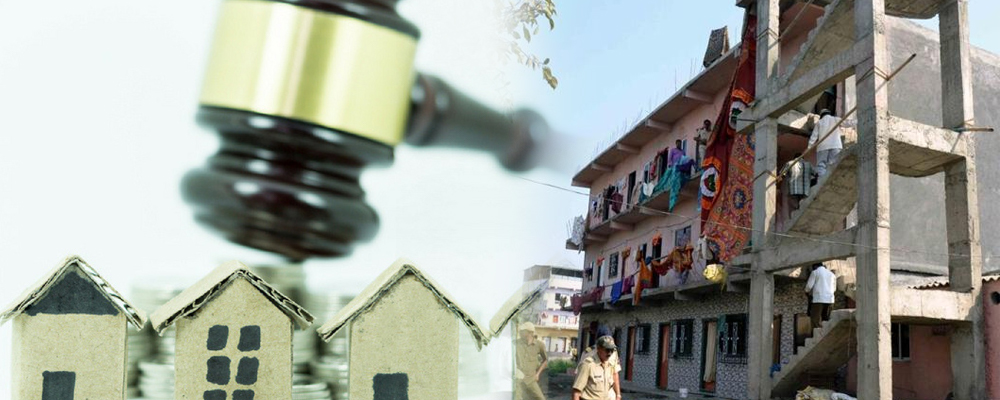There are several permits that must be secured from the government before beginning development on any property, including land clearances, zoning clearances, building approvals, etc. Additionally, you must provide proof of your ownership of the land where the construction will be built. A structure that was created without the necessary permits or in violation of the established standards is not a legal structure. Unauthorised construction is the act of building a structure without a permit. They might potentially be destroyed by the government.
Types of Illegal Construction:
Illegal Construction on Private Land:
- This occurs when the building is carried out on land or property by the owner who is legally entitled to do so but in violation of any legal requirements. It can be unlawful if, for example, The individual carrying out the building did not get the necessary government authorizations.
- The individual executing the construction disregards the established restrictions.
- The individual erecting the structure does not adhere to the regulations established by the government for that type of building.
Illegal Construction on Public Land:
This occurs when building takes place on the property whose ownership does not belong to the individual building it, but rather to the government. This occurs mostly as a result of the socioeconomic issues that are common in a nation, such as poverty, unemployment, a huge population, etc.
Ways To Stop Unauthorised Construction:
The police are only allowed to report these instances to the appropriate authorities and follow their instructions in these situations. The police can only stop illegal buildings after receiving such directives.
Need A Legal Advice
The internet is not a lawyer and neither are you. Talk to a real lawyer about your legal issue

Civic Bodies Complaint:
The civic entities, such as the Delhi Municipal Corporation (DMC) in Delhi, are the government organisations in charge of the successful planning, upkeep, and management of cities. Before beginning the construction of any structure, a certificate of approval of these governmental organisations is necessary. These civic organisations are also responsible for halting unauthorised construction. They have a responsibility to ensure that the law is followed.
The city authorities are required to deny permission if a certain building is being built or permission to build a structure is requested even though doing so would be against the law. The notified Municipal Corporation is responsible for stopping the unauthorised development. A letter against the illegal construction can be sent to the concerned Municipal Corporation.
The individual conducting the work will subsequently receive a notice from the company asking him to respond to the complaint of unapproved construction brought against him within the specified time. The municipal corporation continues with the demolition of the structure if the person doesn’t respond.
A suit in the Court:
The civic entities may not pay attention to the complaints presented. This may be due to a lack of responsibility, a lack of concern for others needs, or the widespread corruption that permeates these civic institutions. The number of illegal structures that have been destroyed and the adamant insistence that Delhi’s sealing program must continue are just two examples of how careless the municipal corporation is about the work they are doing. It becomes impractical for a resident in such a situation to receive assistance from the local government. The Indian Courts intervene in this situation. A legal complaint in the form of a petition under Article 226 can be filed in the High Court.
The eviction of occupants of public property is covered by the Public Premises (Eviction of unauthorised Occupants) Act of 1971. A person may file a lawsuit under the provisions of the article to have an unauthorised building sealed, demolished, or evicted. The Act’s Sections 5A, 5B, and 5C deal with the estate’s officer’s ability to halt the erection of unpermitted structures. The eviction of unauthorised residents who are residing in these structures is also covered in Section 5 of this Act. The Act also addresses any item left behind and the price of incidental damages that the occupant is responsible for.
Important Judgments on Illegal Construction:
Speaking on the subject of unauthorised construction in K. Ramadas Shenoy v. Chief Officers, Town Municipal Council, the Supreme Court of India stated that unauthorised construction interferes with the residents’ ability to use the land. The Court reaffirmed that the zones are designed to meet the needs of the locals. This planning is thwarted by carrying out arbitrary acts of unauthorised construction.
The Supreme Court discussed the risks inherent in defying the approved development designs in Friends Colony Development Committee v. The State of Orissa. The occupants of the built-in premises as well as other city residents, the court ruled, are at risk if the builders veer from the approved plans. The Court also discussed the dangers that such constructions represent to the environment and the ecosystem. According to the Court, the unsuspecting buyers who must deal with the effects of destruction in search of a place to call home are the actual losers in these situations. The builder pockets, enormous sums of money and then securely leaves.





 Talk to a Lawyer
Talk to a Lawyer